Viewing search results for "North Carolina City Directories"
View All Posts
We love being sent or just stumbling upon, projects on the web that utilize materials digitized through the North Carolina Digital Heritage Center. We thought since they have done such a great job highlighting us, it’d only be fair to turn around and highlight a few we’ve found recently.
Today’s featured website is “Black Wide-Awake” which highlights “documents of historical and genealogical interest to researchers of Wilson County, North Carolina’s African American past.”
The site, written by Lisa Henderson and with posts dating back to 2015, utilizes a wide variety of digitized historical resources to document everything from African-American schools in the Wilson area, wills, correspondence, and newspaper articles related to the enslaved people in Wilson County, to official records including marriage, birth, and death records from the Black community.
Some of the DigitalNC resources that are featured on Black Wide-Awake include many of the photographs and other materials from the Oliver Nestus Freeman Round House Museum’s collection.
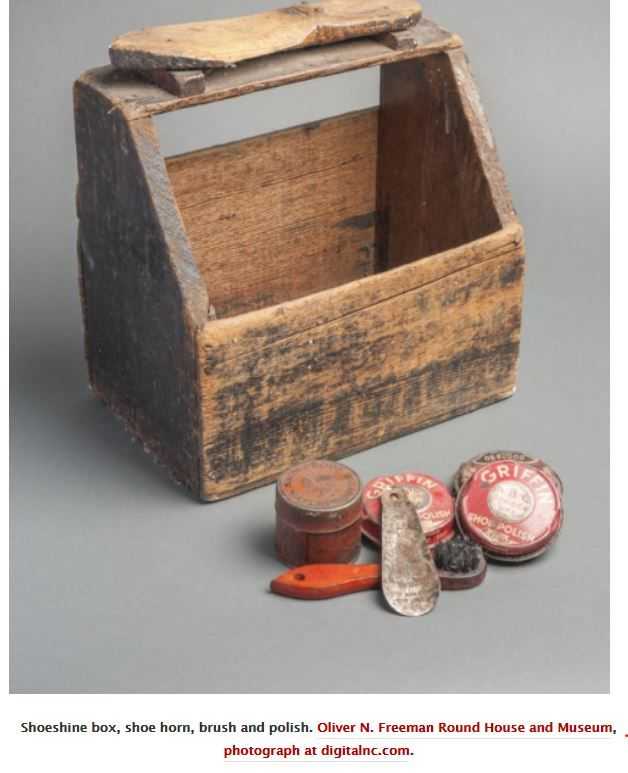
Shoe shine kit from the Oliver Nestus Freeman collection, featured in this post on Black Wide Awake.
Wilson City Directories
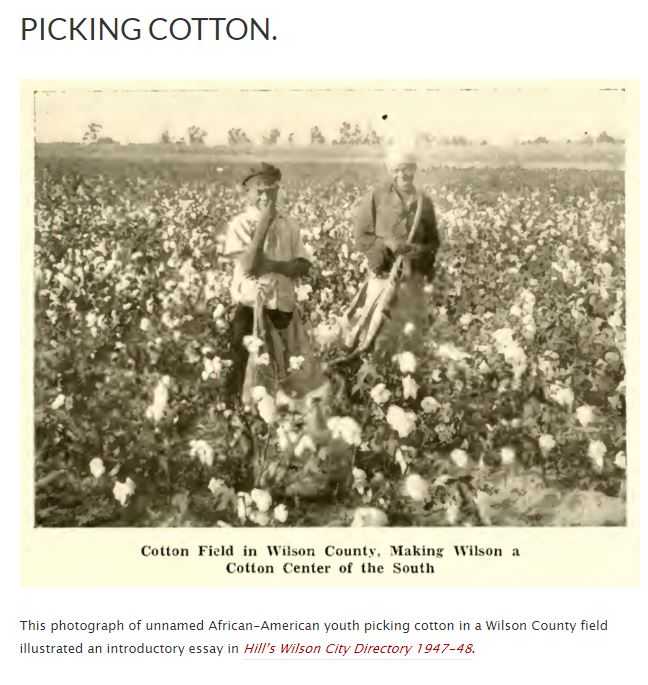
Photograph from the 1947-1948 Wilson City Directory, featured in this post on Black Wide Awake.
Yearbooks from Darden High School, made possible by our partner Wilson County Public Library
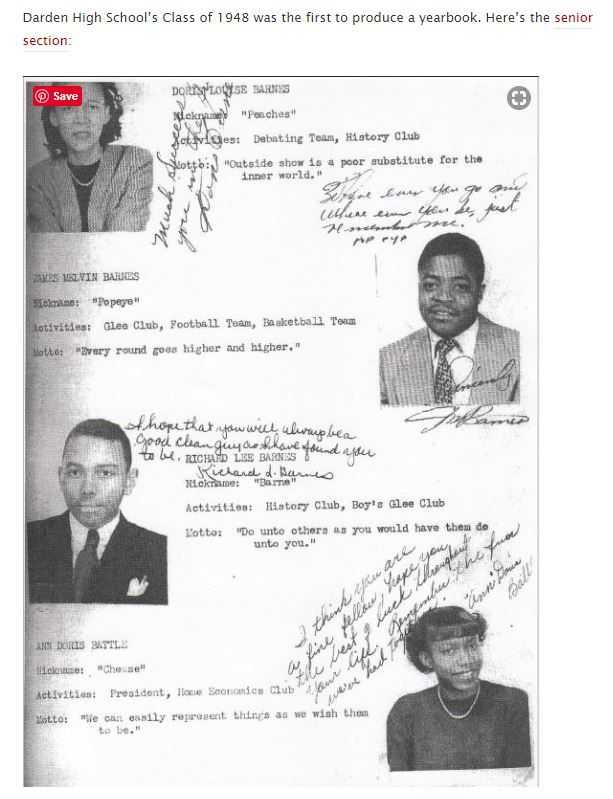
Senior page from the 1948 Charles H. Darden High School yearbook, the first yearbook from the school, featured in this post on the website.
Many newspaper article clippings from DigitalNC are also included. A post discussing the white supremacist views held and pushed by editor of the Wilson Advance, Josephus Daniels, is a recent post that connects directly to the current commentary going on regarding Black Lives Matter and reassessing how we look at our history.
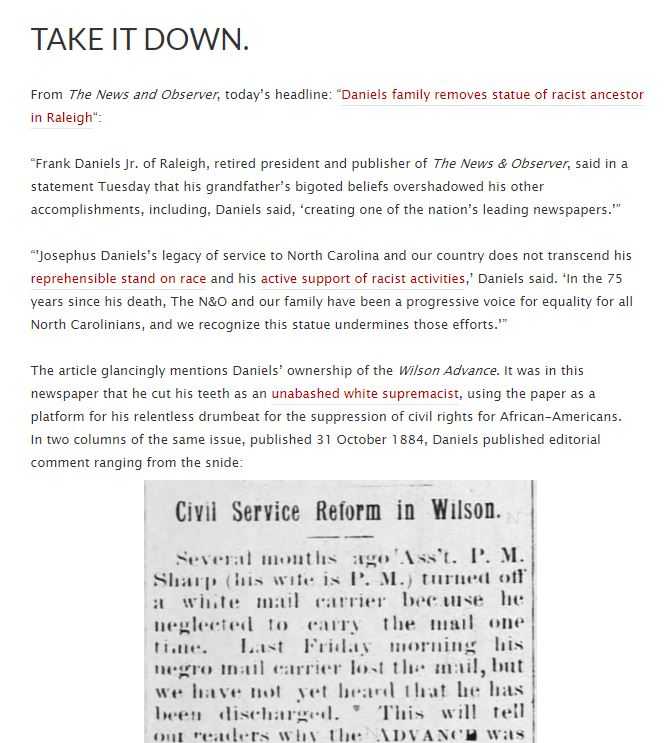
Post on Black Wide Awake pointing out the racist statements the editor and publisher of the Wilson Advance, Josephus Daniels, made regularly in a call to take down any statue or other dedication marker to him in North Carolina.
The work done on this website is a fascinating look into how resources on DigitalNC can really help illuminate a North Carolina community’s past. Thanks for using us Ms. Henderson! We encourage anyone with an interest in genealogy and local history, particularly for the Black community in North Carolina, to visit the site.
If you have a particular project or know of one that has utilized materials from DigitalNC, we’d love to hear about it! Contact us via email or in the comments below and we’ll check out. To see past highlighted projects, visit past posts here.
We love hearing about ways that materials digitized through the North Carolina Digital Heritage Center have impacted research and recreation. We thought since they have done such a great job highlighting us, it’d only be fair to turn around and highlight a few we’ve found recently.
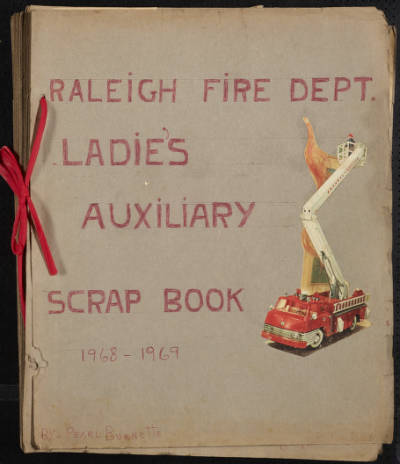
Cover page of the Raleigh Fire Department Ladies’ Auxiliary 1968-1969 scrapbook, digitized for the Raleigh Fire Museum
Our focus today is a particularly fun one because the author of the blog is not only a heavy user of DigitalNC, but also our main contact for one of our partners, the Raleigh Fire Museum. Mike Legeros’s Fire Blog provides a very detailed look into the history of fire departments in North Carolina, as well as keeping up to date on what’s going on in those departments today. It also links to a Fire History page, which has resources of the history of fire departments across the country, including historic and present day photographs of fire stations.
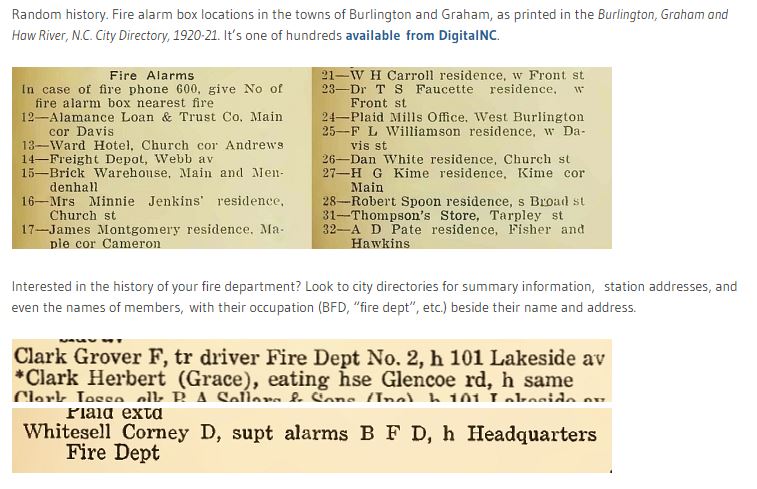
We are particular fans of the post that explains in great detail how to use our city directories, which is one of our favorite resources on DigitalNC and one that Mike has used extensively in his research. You can check out his tips and tricks here: https://legeros.com/blog/burlington-and-graham-fire-alarm-box-locations-1920-21/
If you have a particular project or know of one that has utilized materials from DigitalNC, we’d love to hear about it! Contact us via email or in the comments below and we’ll check out. To read about other places on the web that feature content from DigitalNC, check out past blog posts here.
We are one of 29 finalists for the Institute of Museum and Library Services 2018 National Medal for Museum and Library Service. Now through April 13, IMLS is asking the people who have been impacted by the Digital Heritage Center to share their stories. If you have a story you’d like to share, we’d love to hear from you! Please contact us or share via social media by tagging us on Facebook (@NC Digital Heritage Center) or on Twitter (@ncdhc).
Today’s story comes from Taneya Y. Koonce, a native North Carolinian, information professional, and a well known genealogist. She shares her research and methods on Taneya’s Genealogy Blog and her new Koonce surname site. One of her projects includes indexing names from digitized yearbooks to help improve searchability by transcribing names. Taneya shared the thoughts below in support of our Medal application and we reshare them today with her permission.
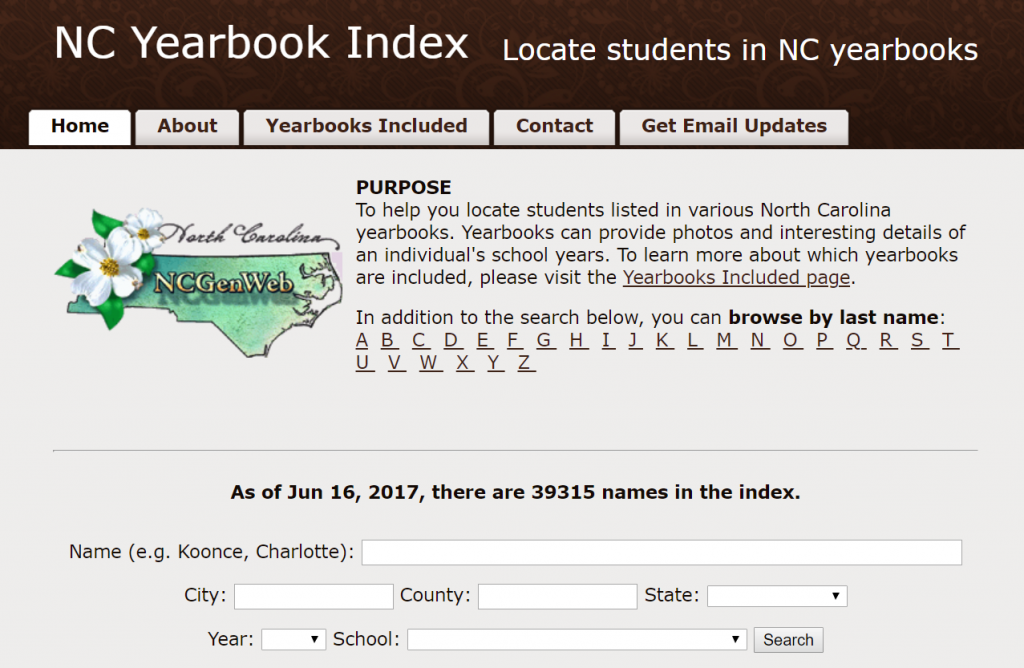 “My interest in the NCDHC stems from my passion for researching family history and genealogy. I am a native North Carolinian and over the past 12 years I have been an active participant in the online genealogy community as I’ve researched not only my own family tree, but aided in the research of many others. I have high visibility in the genealogy community and maintain leadership roles in the national USGenWeb Project, a volunteer-driven group that provides free resources to individuals researching their family heritage. I am currently the Assistant State Coordinator in the North Carolina-focused component of the project (the NCGenWeb) and work closely with researchers from across the country who have family roots in the state. I spearhead several projects designed to further maximize the reach and impact of the NCDHC work (such as an online index to graduating seniors listed in the yearbooks from the digitized yearbook collection), and have become intimately familiar with the Center’s collections.
“My interest in the NCDHC stems from my passion for researching family history and genealogy. I am a native North Carolinian and over the past 12 years I have been an active participant in the online genealogy community as I’ve researched not only my own family tree, but aided in the research of many others. I have high visibility in the genealogy community and maintain leadership roles in the national USGenWeb Project, a volunteer-driven group that provides free resources to individuals researching their family heritage. I am currently the Assistant State Coordinator in the North Carolina-focused component of the project (the NCGenWeb) and work closely with researchers from across the country who have family roots in the state. I spearhead several projects designed to further maximize the reach and impact of the NCDHC work (such as an online index to graduating seniors listed in the yearbooks from the digitized yearbook collection), and have become intimately familiar with the Center’s collections.
“When the NCDHC began, I was immediately excited by their emergence and the potential for the wealth of resources that would be made more broadly available to those with North Carolina-related family history and historical interests. The digitization of state materials offers increased access for many such as myself, who are unable to visit the physical locations where these resources are housed. The breadth of material the NCDHC makes available – yearbooks, newspapers, images & memorabilia, city directories, and audio-visual resources, are a cross-cutting representation of the many format types historians, educators, and genealogists leverage for our respective fields of inquiry. Staff at the Center also incorporate industry-leading approaches to content delivery; such as the reader used for displaying historic newspapers which is an adaptation of the Library of Congress (LOC) platform for their monumental ChroniclingAmerica.gov site. The NCDHC is just one of the few institutions that have adopted the LOC reader; a move which embodies the Center’s willingness to offer innovative solutions to site visitors. NCDHC participates in the Digital Public Library of America, contributes code to GitHub, and most recently has been purposeful in expanding the diversity of collection materials. These efforts are demonstrative of the Center’s strive for excellence. The Center has worked with steady focus to expand the geographical representation of the digital collection and currently has material from libraries, archives, schools, and cultural institutions from across the entire state – a quite admirable feat. Through their social media platforms, the Center also regularly engages in discourse with their constituents, providing timely and thoughtful replies to submitted questions; I’ve found their customer service to be at the highest caliber.”
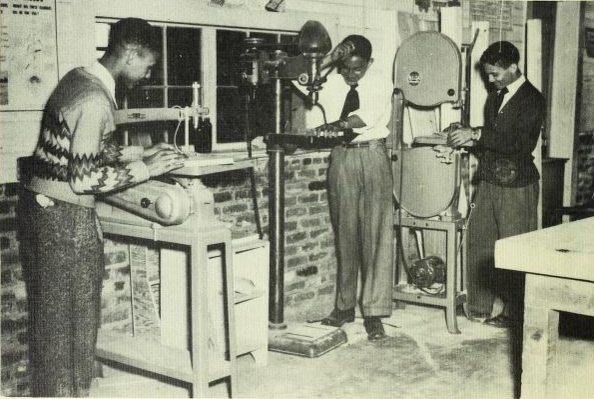
“New Farmers of America,” from the Carver High School yearbook, Hi-Lite, 1949.
Eleven new yearbooks provided by Forsyth County Public Library have been digitized and added to DigitalNC. All eleven are from Carver High School in Winston-Salem, North Carolina, dating from 1949 to 1969. The yearbook was titled “Hi-Lite” until 1949, then “Yellow Jacket” from 1950 onward. Carver High School is a historically Black school founded in 1936 and still open today; the yearbooks include photographs of students, staff, class activities, athletics, clubs, and superlatives.
You can view more yearbooks from Forsyth County Public Library in our North Carolina Yearbooks collection. Plus you can see more materials from Forsyth County Public Library, including yearbooks, city directories, memorabilia, and photographs.
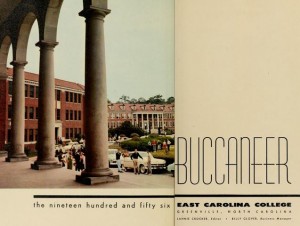
Title page from the 1956 Buccaneer, from East Carolina College, the most popular item on DigitalNC.org in 2014.
The North Carolina Digital Heritage Center had a great year in 2014. We continued to work with partners around the state on digitization projects and added a wide variety of material to DigitalNC.org, making it easier than ever for users to discover and access rare and unique materials from communities all over North Carolina.
As we look back on our work over the past year, I wanted to share some of what we’ve learned by looking at our website usage statistics. Like many libraries, the Digital Heritage Center uses Google Analytics to capture information about what’s being used on our website, who’s using it, and how they got there. While there are still lots of questions remaining about usage of DigitalNC, these stats do give us a lot of valuable information.
In 2014, more than 250,000 users visited DigitalNC.org, resulting in more than 1.8 million pageviews. While people visited our website from computers located all over the world, the greatest number by far came from North Carolina. That’s what we expected and hoped to see. More than 200,000 sessions originated in North Carolina, with the users coming from 388 different locations, ranging from over 18,000 sessions in Raleigh and Charlotte to a single visit from the town of Bolivia in Brunswick County (user location is determined by the location of their internet service provider, so this may not tell us exactly where our users are located, but it’s going to be close in most cases).
What did people use on DigitalNC? We were not surprised to find that the most popular collection remains our still-growing library of yearbooks. The North Carolina Yearbooks collection received more than 125,000 pageviews alone, followed by newspapers (44,000) and city directories (11,000). And we were pleased to learn that at least somebody is reading this blog, which received nearly 2,500 pageviews last year. The most popular blog post was our announcement about the digitization of a large collection of Wake County high school yearbooks.
We were also curious to see what single items were the most popular over the past year. The winner, with 438 pageviews, was the 1956 yearbook from East Carolina University. The second most popular was also from East Carolina, the 1930 Tecoan, followed by the 1961 yearbook from the Palmer Memorial Institute and the 1922 yearbook from Appalachian State University.
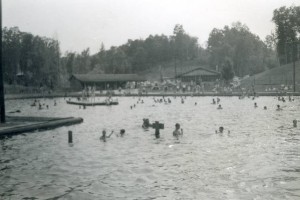
Lake Hideaway, ca. 1950s, the most popular photo on DigitalNC.org in 2014.
The most popular image on our site was from the Davie County Public Library: a black-and-white photo from the 1950s showing swimmers at Lake Hideaway in Mocksville. Other popular photos included a postcard showing the American Tobacco Company plant in Reidsville, N.C., a group of Stanly County students from 1912, and a portrait of Charles McCartney, the infamous “Goat Man” from the 1950s.
The variety of subjects, locations, and time periods in these photos is representative of the wide-ranging content available in North Carolina’s cultural heritage institutions and on DigitalNC.org. We are honored and excited to have a role in making this content accessible to everyone and look forward to sharing even more of North Carolina’s history and culture online in 2015.
As the school year comes to a close across the state, it seems like a good time to take a more in-depth look at the wealth of information that can be found in the more than 1,600 high school yearbooks that we have scanned and made accessible on DigitalNC in the past year. While the most obvious use of these yearbooks is for genealogical purposes, they contain much more than just portraits and can tell a lot about the towns and time periods they come from.
As our high school yearbooks are only available through the year 1964, there is not a lot of integration of North Carolina schools evident in the yearbooks. However, the yearbooks available in DigitalNC do come from both white and Black schools, often in the same towns, dating back to the early 1900s. This can allow comparison of how the schools operated and a view into life in segregated schools in North Carolina. For example, in Tarboro, there was Tarboro High School, the white school, and Pattillo High School, the Black school. Our yearbooks from both cover the 1940s-1950s.
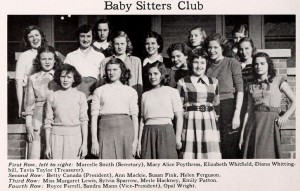
from 1949 Chapel Hill High School yearbook “Hillife”
In many of the yearbooks in the North Carolina High School Yearbooks collection there are extensive sections dedicated to both the clubs and the athletics at the school. These sections, with many group portraits, action shots, and sometimes even added explanation, provide a glimpse into what extracurricular activities students participated in throughout the years. For example in the 1949 Chapel Hill High School yearbook there is a babysitter’s club pictured, and in the 1929 R.J. Reynolds High School Black and Gold yearbook, there is a photograph of the “Salemanship club.” Beyond being interesting in their own way, this information shows how priorities for school age children and the expected responsibilities they have shift over time.
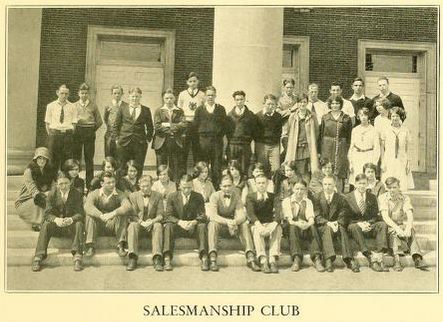
from 1929 R.J. Reynolds High School yearbook “Black and Gold”
Most of the yearbooks contain information on the teachers at the school and the courses and subjects they taught. Again, like the clubs, this information provides insight into how subject emphasis in school has changed over time. The page below from the 1963 Lion yearbook from P.W. Moore Junior-Senior High School in Elizabeth City includes photographs from classes that are not often seen anymore, including agriculture, typing, and guidance class.
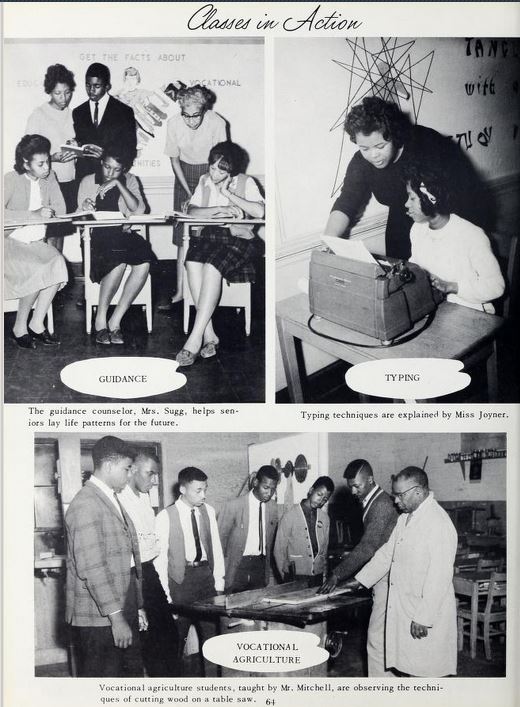
Some of the classes offered at P.W. Moore Junior-Senior High School in 1963
The yearbooks also contain a lot of images of events that occurred at the schools. A few weeks ago we pointed out the wonderful May Day images from across the decades. Other events such as prom, homecoming, and school specific traditions are included in the yearbooks. Below is a schedule of events from the 1941-1942 school year at Hickory High School.

1941-1942 Hickory High School schedule, from the “Hickory Log.”
Current events of the day are also featured in these yearbooks. For example, those published during World War II often have heavy patriotic themes and some, such as the High Point High School yearbook from 1945, have whole spreads dedicated to those lost from High Point, particularly fellow classmates, in the war.
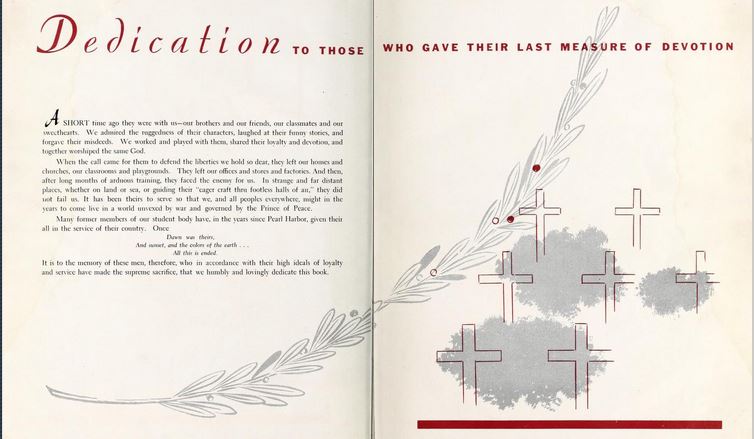
Dedication page to those killed in World War II from High Point High School, from the 1945 Pemican
The advertising section at the back of the yearbooks offer a glimpse at the businesses of the town the school is in, which can be particularly useful for small towns that may not have had their own city directories. The listings usually include addresses for the businesses, and sometimes, as is the case in the 1960 Pittsboro High School yearbook, photographs of the businesses themselves. These photographs can be the only images of businesses that shut down years ago.
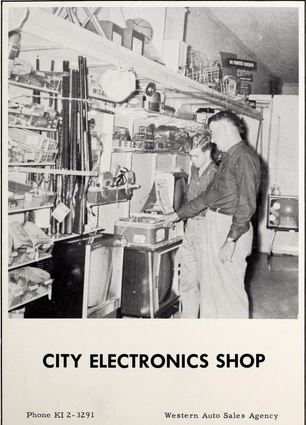
City Electronics Shop ad in Pittsboro High School’s 1960 The Dragonian
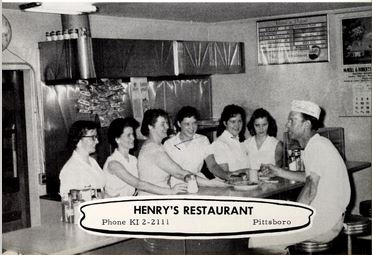
Henry’s Restaurant ad, in Pittsboro High School’s 1960 The Dragonian
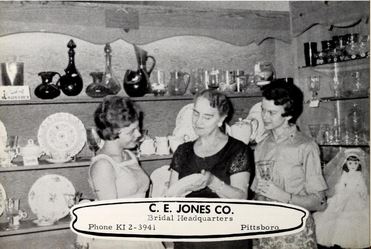
C.E. Jones Co. Bridal Headquarters ad, in the Pittsboro High School 1960 The Dragonian
As graduation approaches for high-schoolers across the state, spend some time looking through our high school yearbook collection and take a peek into life as a high school student fifty years or more ago. If you know of high school yearbooks at a local institution in North Carolina that are not currently included in our collection, go here to learn more about how to get them included on DigitalNC.
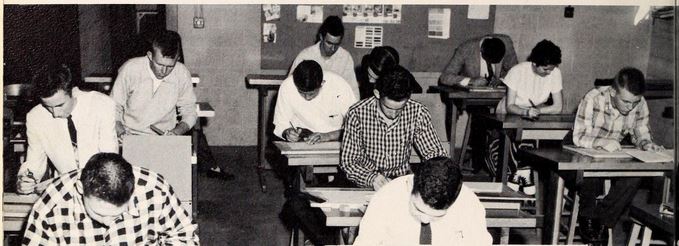
Students in Industrial Arts at New Bern High School hard at work, 1958 The Bruin
Over 40 yearbooks and other published materials from Craven County are now online on DigitalNC, thanks to the New Bern-Craven County Public Library. The yearbooks and catalogs come from schools across Craven County and include:
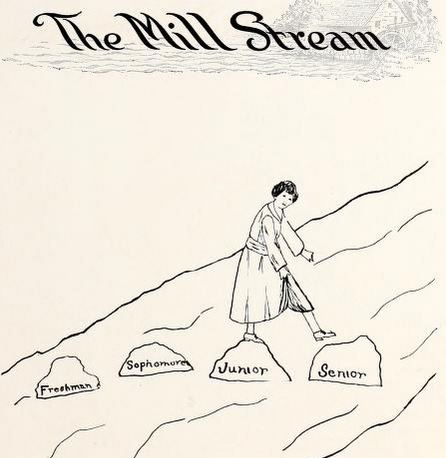
Drawing from the 1924 Mill Stream, from the Craven County Farm Life School
City directories for New Bern covering 1904-1915 are also included in the batch from Craven County. To view more materials from across North Carolina, visit DigitalNC.
Monday Matchup
Here on our blog, we occasionally feature “matchups” that showcase relationships between different items in our collection. Today’s matchup? Cartoons from the Hickory Democrat and information from Charlotte City Directories.
A number of community newspapers on DigitalNC have cartoons; not many of those cartoons describe local content, which is why the recently published Hickory Democrat caught our eye. Scanning front page after front page during 1906-1907, right under the masthead, are cartoons commenting on items of US and local significance. They’re signed “Hutch” and sometimes say “Courtesy The Charlotte News.”
The usual Googling didn’t turn up much, and we couldn’t find any reference to Hutch in the Hickory Democrat besides the cartoons, so we turned to The Charlotte News. From the News, we were able to piece together more about the artist.
Hutch was the pen name of cartoonist Andrew C. Hutchinson, a Charlotte resident who began drawing cartoons for the News in his late teens. His talent was well respected, especially in light of his age. The News occasionally has articles related to Hutch’s career, mentioning that his cartoons were reprinted around the state (as in the Hickory Democrat) and beyond (the Atlanta Journal republished a cartoon in 1909).
The first reference to Hutch as a cartoonist is in the August 25, 1903 News, which states “Mr. Andrew Hutchinson, Charlotte’s clever young cartoonist, is seriously ill with malarial fever.” The first of his cartoons we located in the News are in the May 30, 1906 issue, which sports two on the front page:
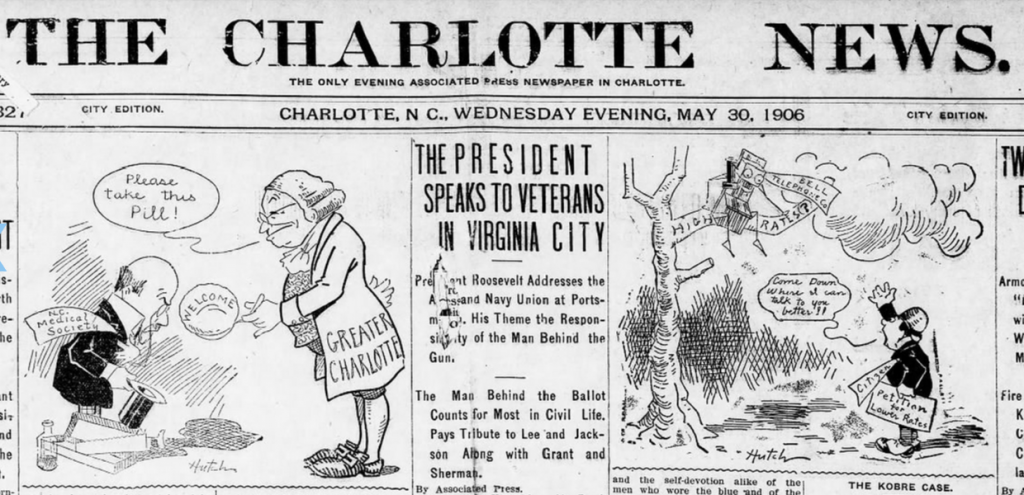
Charlotte News, 1906-05-30, page 1. Available through Newspapers.com.
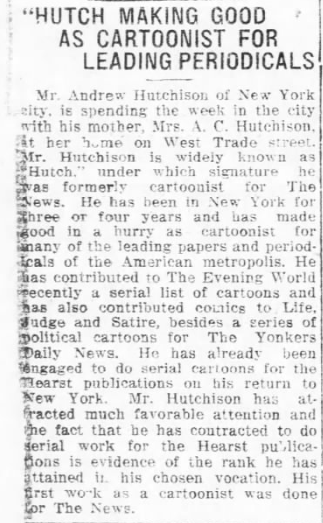
Charlotte News 1915-01-16, page 12. Available through Newspapers.com.
Sometime between March 1910 and December 1911, Hutch moved to New York to draw for the New York World. The clipping at right, from the January 16, 1914 News, proudly describes Hutch’s New York career, which was flourishing as he provided content for Life, Judge, Satire, and The Yonkers Daily News, and as he signed on to work for the Hearst Corporation.
What else do we know about Hutch? A 1910 Charlotte City Directory lists “Hutchinson, Andrew C. Jr. cartoonist” residing at 711 W. Trade Street. It looks like he’s there with his father and mother*, Andrew and Antoinette Hutchinson, as well as two brothers (James L. and John W.). He isn’t listed in the 1911 directory, which makes sense with his purported move to New York. From that 1911 directory, we unfortunately find out that his father passed away as Antoinette is listed as a widow.
This is as far as we got in tracking down Hutch. His cartoons don’t appear in the Hickory Democrat past 1907. We don’t know how long he worked in New York, how his career progressed, or where he ended up. If you have any clues, let us know.
*We know that Andrew, Antoinette, James and John are family from the 1910 census record, which also tells us that Andrew Jr. was born around 1886. Census Record Citation: Year: 1910; Census Place: Charlotte Ward 3, Mecklenburg, North Carolina; Roll: T624_1121; Page: 19A; Enumeration District: 0102; FHL microfilm:1375134
This week our colleagues at the North Carolina State Library are focusing on Halifax County as their county of the week. We are taking the opportunity to again dive a bit deeper into some of our city directories from that county. Two cities from Halifax County have directories in DigitalNC: Roanoke Rapids and Scotland Neck.
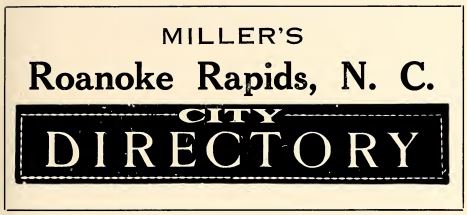
The directories from Roanoke Rapids, which cover 1938 until 1963, were all published by the Southern Directory Company, which was based in Asheville, NC, and are all Miller’s Directories. Roanoke Rapids, which is Halifax County’s county seat, was a rapidly growing town during the period the directories were published. In addition to the expected listings of businesses and addresses of citizens of Roanoke Rapids, the directories all include detailed descriptions of facilities in the town, including public works, churches, schools, and amusements. There are also descriptions of the population of the town and all the counties in NC, and the tax rates in the town and county at the time.

Directory of local facilities in town from the 1938 Roanoke Rapids City Directory
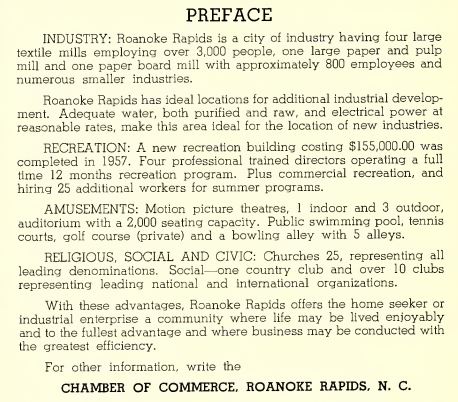
Information about facilities in town from the 1958 city directory
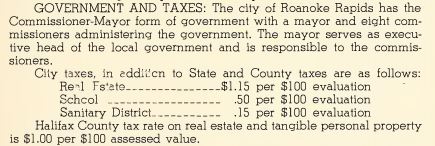
Taxes in Roanoke Rapids from the 1958 city directory
There are two directories from Scotland Neck, which cover 1960-1962. Scotland Neck’s directories were published by Hill Directory Co., Inc., based out of Richmond, VA. These directories do not included detailed descriptions of the town, just the basic ads, telephone directory and address directory for Scotland Neck and the surrounding area. The ads in the Scotland Neck directories all include well done drawings by the publication company, making that section more appealing for consumers compared to the Miller directories for Roanoke Rapids.
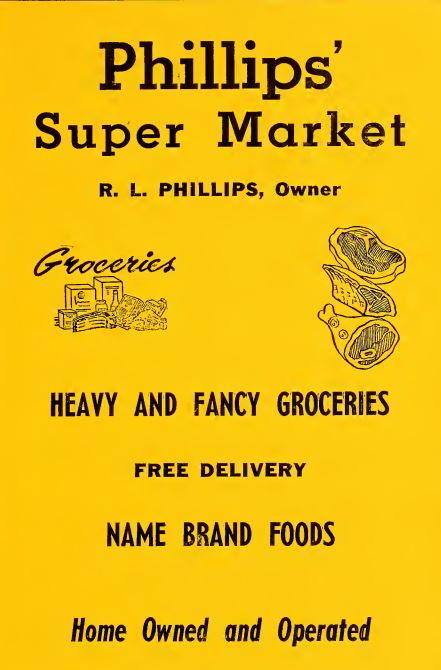
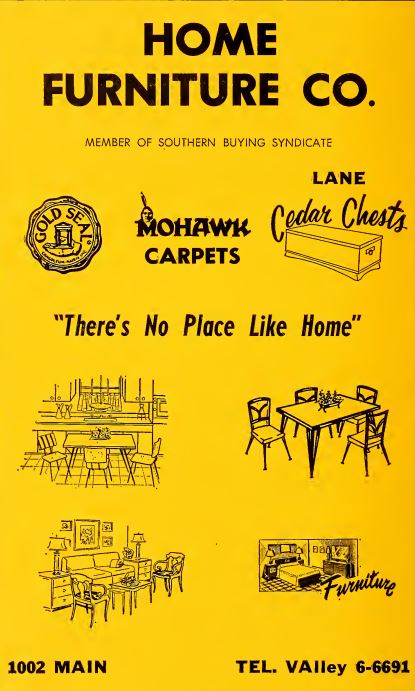
To learn more about city directories, check out past blog posts here. And to view more city directories from across North Carolina, visit the City Directories Collection on DigitalNC.




























